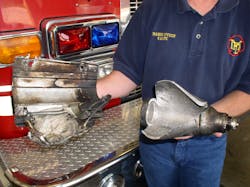University of Extrication: Airbag Supplemental Restraint Systems—Part 2
Subject: Airbag Supplemental Restraint Systems
Topic: Airbag Inflators Under Vehicle Fire Conditions
Objective: Understand how airbag supplemental restraint system inflator units react under vehicle fire conditions
Task: Given a vehicle that has been well involved in fire, responders will inspect the airbag restraint systems and determine how they reacted during the vehicle fire.
In Part 2 of our discussion of passenger vehicle airbags in fires, we look at two incidents where the stored gas inflator for a supplemental restraint airbag was heated to its failure point during a vehicle fire. In both of our case studies, the occupant area of the vehicle was fully involved at some point during the fire.
Remember, gas pressures inside a typical stored gas inflator for an airbag will range from between 6,400 psi to over 8,200 psi. These are high pressures, especially when considering that the sealed inflator has no pressure-relief valve or vent mechanism built into it. In the best-case scenario, the potential exists for the stored gas inflator to simply release its pressure through the normal tubing connected to the airbag during the height of the fire. If this occurs during a vehicle fire, the risk to firefighters is minimized. You may hear a bang as the nylon airbag inflates, but it will instantly melt away in the fire.
Windshield wipeout
When a stored gas inflator over-pressurizes, however, and fails by rupturing, that is when responders are at a much greater risk. That is what happened in our first incident. A 2003 Dodge Neon sedan was fully involved in fire upon the arrival of the engine company. Only after knocking down the passenger compartment fire did the captain realize that pieces of the airbag and its ruptured stored gas inflator were lying in the roadway a distance of 120 feet ahead of the burning vehicle.
At some point during this fire, the windshield glass would have melted down. As the large, stored gas inflator for the passenger front airbag reached its over-pressurization point, the cylinder failed violently. As the inflator exploded, the now flattened cylinder, along with the bracket for the passenger frontal airbag, tore off their mounting, flew through the windshield opening, and landed ahead of the vehicle. Fortunately for responders, this occurred prior to their arrival.
Prepare for launch
In our second inflator failure incident, the two stored gas inflators for the front seat-mounted side impact airbags both failed due to overheating. In this case, however, the smaller diameter inflators did not rupture open like in our first incident. Instead, these seat airbag inflators literally launched out of the vehicle like a rocket. Because they were mounted vertically along the frame of the seatback, when they failed, they tore off the seatback frame and flew straight upward with enough force to tear through the metal roof above them. Holes in the roof directly above where each inflator was originally mounted were evident during the post-fire investigation.
The teaching point of this “Airbags in Fire” series is to raise the awareness that stored gas inflators for airbags are in practically every passenger vehicle you will encounter. The hazards they present due to overheating in a vehicle fire are real. Fire officers need to be aware of these hazards and have their crews attack vehicle fires with personnel safety in mind at all times. A passenger vehicle with open flames visible upon your arrival will most likely be declared a “total loss” by the insurance company. Respect the hazards that a burning vehicle presents and don’t drop your guard at any time during the vehicle fire incident.
Until the fire is out and the airbag inflators have cooled back down to normal temperatures, they should be considered a ticking time bomb that must be respected for its potential to fail violently and injure personnel within their “strike zone.”
Read Part 1 here.

Ron Moore
RON MOORE, who is a Firehouse contributing editor, recently retired as a division chief with the McKinney, TX, Fire Department and now serves with Prosper, TX, Fire Rescue. He self-published the Vehicle Rescue 1-2-3 training manual and serves as the forum moderator for the extrication section of Firehouse.com . Moore can be contacted directly at [email protected].






